|
Additional Lessons |
 About These
Lessons About These
Lessons
The following classroom lessons are great for students
who want additional listening and reading practice. |
-
Travel America -
Beginner
Level. Do you love America and American
English? Learn before you travel. Facts and other
cool stuff about your favorite U.S. state. Great
English reading practice.
|
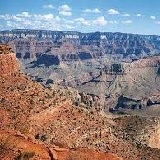 Travel
America - South Dakota Travel
America - South Dakota
(Beginner -
Reading)
Learn some interesting facts and read interesting
stories about South Dakota. |
 South
Dakota South
Dakota
A Great Plains state, South Dakota was named for the
Dakota division of the Sioux Indians, and is known
as the Coyote State. Admitted simultaneously with
North Dakota after the Dakota Territory was divided
along the 46th parallel, South Dakota is mainly a
rural state. Today, just less than 10 percent of its
population is American Indian. South Dakota is known
for two monumental sculptures carved into the Black
Hills--Mount Rushmore, which honors presidents
Washington, Jefferson, Lincoln, and Theodore
Roosevelt, and the Crazy Horse Monument, still under
construction, which honors the Oglala Sioux war
chief. The state flower is the pasqueflower, also
called the May Day flower; its blooming is one of
the first signs of spring in South Dakota. |
South Dakota
State Flag
The state flag of South Dakota features the great
seal on a blazing sun in the center against a field of sky
blue. The words "South Dakota" appear above the seal and the
official state nickname appears below; "The Mount Rushmore
State." South Dakota flags that are designed for indoor and
display use have a golden fringe on three sides.
The symbols on the great seal of South Dakota represent the
state's commerce, industry, and natural resources. "Under
God the People Rule" (South Dakota's state motto) appears at
the top of the inner circle, which has a background of sky
and hills. In the foreground, a steam ship navigates a river
running through agricultural and industrial land. The outer
circle of the seal bears the words "State of South Dakota,"
"Great Seal," and "1889" (the year South Dakota became a
state).
Pledge to South Dakota Flag
The official pledge to the state flag is: "I pledge loyalty
and support to the flag and state of South Dakota, land of
sunshine, land of infinite variety." |
|
Source:
State Symbols USA |
|
|
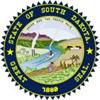 South Dakota
State Facts South Dakota
State Facts
Picture: state seal of South Dakota |
|
State Capital |
Pierre (Pronounced Peer) |
|
Nickname |
Mt. Rushmore State / Coyote State |
|
Motto |
Under God the People Rule. |
|
Statehood |
November 2, 1889 (39th or 40th -- Admitted the same
day as ND.) |
|
Origin of Name |
Dakota is a Sioux Indian word for "friend." |
|
Largest Cities |
Sioux Falls, Rapid City, Aberdeen, Watertown,
Brookings |
|
Border States |
Iowa, Minnesota, Montana, Nebraska, North Dakota,
Wyoming |
|
Area |
75,898 sq. mi., 16th largest |
|
State Bird |
Ring-necked Pheasant |
|
State Flower |
Pasqueflower (pulsatilla hirsutissima) |
|
State Tree |
Black Hills Spruce (picea glauca) |
|
State Song |
Hail, South Dakota |
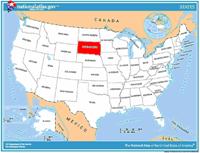 Travel and tourism site
for South Dakota - This state travel and territorial
tourism site provides ideas for your vacations, meetings, and more. Travel and tourism site
for South Dakota - This state travel and territorial
tourism site provides ideas for your vacations, meetings, and more. |
|
|
South Dakota Stories |
|
|
The Corn Palace
Imagine a building covered with colorful murals. Now imagine that
same building with an exterior made entirely out of corn and other
grains! This building exists -- it is the Corn Palace.
Built in 1892 in Mitchell, South Dakota, the Corn Palace was created
to dramatically display the products of the harvest of South
Dakota's farmers, in murals on the outside of the building. The
murals are made from thousands of bushels of corn and other grains
and grasses such as wild oats, rye, straw, and wheat. Each year
these corn decorations are completely stripped down and entirely new
murals are created. The Corn Palace is a great tourist attraction
and a meeting place for the community. Many events are held here and
the most popular is the Corn Palace Stampede Rodeo. But the horses
must be watched carefully so they don't eat the building! |
|
|
Black Hills, South Dakota
The Black Hills is a hilly region of pine forests, caves, lakes,
canyons, and prairies that, from a distance, looks black. American
Indians such as the Lakota considered the Black Hills to be a sacred
area and hunting ground. By the late 19th century, however, the U.S.
government drove the Indians out after white miners discovered gold
in the hills.
Today, large parts of the Black Hills are park areas that tourists
enjoy. They are also home to various wildlife, including bison, elk,
coyotes, and prairie dogs. This is a special refuge for bison in
particular because white men slaughtered so many in the 19th century
that they almost became extinct at the beginning of the 20th
century. Since then efforts have been made to protect them. Now
bison herds have increased to the hundreds of thousands. |
|
|
Mount Rushmore National Memorial
Can you name the presidents carved on Mount Rushmore?
Carving started on the amazing Mount Rushmore National Memorial in
1927. It continued for 14 years, with the help of more than 350
people. The faces of four presidents are carved into the
mountainside: George Washington, Thomas Jefferson, Abraham Lincoln,
and Theodore Roosevelt. At first, there was a suggestion to carve
famous western figures, people like Buffalo Bill, Lewis & Clark, and
Sacagawea. But a special group, a "commission," instead chose these
presidents because they best represented the "foundation, expansion
and preservation" of the United States.
A sculptor named Gutzon Borglum was asked to design Mount Rushmore.
He chose the dramatic setting for this sculpture in the Black Hills
of South Dakota. He decided that the best way to remove large pieces
of rock from the mountain was to use dynamite. He and his workers
became skilled at carving Mount Rushmore using carefully placed
dynamite. In fact, more than 90 percent of the mountain was carved
by dynamite! The rest was finished using air hammers. The faces of
the presidents were finished one by one, Washington in 1930,
Jefferson in 1936, Lincoln in 1937 and Roosevelt in 1939.
Today, Mount Rushmore is one of the most recognized monuments in the
United States, with more than 2.7 million visitors each year. |
|
|
Tabor Czech Days
Are there any food recipes that your family has passed down from one
generation to another? If you are Italian, that might be a recipe
for a delicious spaghetti sauce. Irish? Maybe your grandmother had a
secret recipe for soda bread. African American? Perhaps there is a
special way of making greens.
If you are Czech, there is probably a great recipe for kolaches
(pronounced koh-lah-chus) in your family. This is a bun-shaped
pastry traditionally served at weddings. Recipes for kolaches are
protected family secrets, passed down through generations, because
every Czech wants to make the most delicious kolaches. A kolache can
be filled with all kinds of things: apricots, cherries, prunes,
sweetened cottage cheese, poppy seeds, cabbage, sausage ... or
anything else that a kolaches maker thinks would taste good! What
kind of kolache would you make?
Tabor, South Dakota, celebrates its heritage every year with a
festival called Czech Days. Around 1869, settlers came from
Czechoslovakia to form this small South Dakota community. During
Czech Days, Tabor is filled with the sound of polka music and the
wonderful smell of freshly baked kolaches. |
|
|
Northern Plain Tribal Arts Exposition
How can you tell that a Native American made the dress in the photo?
Is it because Native Americans have a unique style of traditional
dress?
The Northern Plains Indians have artistic traditions that they want
to preserve. Every September in Sioux Falls, South Dakota, they hold
the Northern Plains Art Expo to display and promote their artwork.
The event features the works of about 100 Native American artists
from 33 tribes of the Northern Plains states. The Expo has attracted
about 5,000 visitors each year, including art collectors from around
the world. Nationally acclaimed experts in the field of Native
American art act as judges in the show.
Each year an artist is selected as the event's promotional artist.
The artist's work is featured on posters, brochures, and T-shirts.
Prizes and ribbons are awarded to the outstanding artist in the
categories Best of Fine Arts and Best of Tribal Arts. The Art Expo
is sponsored by American Indian Services, an organization that works
to promote Native American people's unique customs. |
|
|
Custer State Park
Do you know what an endangered species is? It's a plant or animal
that is in danger of extinction. The bison, or buffalo, was an
endangered species in the United States. Before Europeans came to
America, huge numbers of bison roamed free on the prairies -- about
30 million! European settlers hunted them eagerly, believing that
there would always be a continual supply of wild bison.
Unfortunately, they were wrong. So many bison were hunted that by
1890 there were only 750 animals left. A law was passed to protect
them, and today most bison live in parks and wildlife reserves.
Custer State Park was the first state park created in South Dakota,
in 1897. It's also South Dakota's largest state park, covering
73,000 acres. The park contains lakes, prairies, and pine forests.
These settings are the perfect homes for many kinds of wildlife,
such as elk and bighorn sheep, like the rams in the photo. Herds of
bison also live in the park. Today, there are about 80,000 to 90,000
bison, thanks to efforts to preserve the species. |
|
Source:
Library of Congress |
|
 National
Forests, Parks, and Monuments of South
Dakota National
Forests, Parks, and Monuments of South
Dakota
The following is a description of national
forests, parks, and monuments in the state
of South Dakota. If you plan to visit or
live in South Dakota for awhile then you
should definitely plan to visit some of
these fantastic places. |
|
|
|
National Forests |
 Custer Custer
Custer National Forest includes the
Beartooth Highway and the Capitol Rock and
the Castles National Natural Landmarks. The
forest's Absaroka-Beartooth Wilderness
includes Granite Peak, the highest point in
Montana at 12,807 ft (3,904 m). This
national forest is also partially located in
the state of Montana. |
 Black
Hills Black
Hills
Consisting predominately of Ponderosa pine,
this forest is located in the namesake Black
Hills. There are 11 reservoirs, 353 mi (568
km) of trails, and 1,300 mi (2,100 km) of
streams in this forest. Black Elk Peak is
the highest point in South Dakota and the
highest point in the United States east of
the Rocky Mountains at 7,244 ft (2,208 m).
This national forest is also partially
located in the state of Wyoming. |
|
|
|
National Parks |
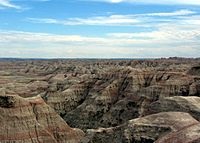 Badlands Badlands
The Badlands are a collection of buttes,
pinnacles, spires, and mixed-grass prairies.
The White River Badlands contain the largest
assemblage of known late Eocene and
Oligocene mammal fossils.[16] The wildlife
includes bison, bighorn sheep, black-footed
ferrets, and prairie dogs. |
 Wind
Cave Wind
Cave
Wind Cave is distinctive for its calcite fin
formations called boxwork, a unique
formation rarely found elsewhere, and
needle-like growths called frostwork. The
cave is one of the longest and most complex
caves in the world. Above ground is a
mixed-grass prairie with animals such as
bison, black-footed ferrets, and prairie
dogs, and ponderosa pine forests that are
home to cougars and elk.[106] The cave is
culturally significant to the Lakota people
as the site "from which Wakan Tanka, the
Great Mystery, sent the buffalo out into
their hunting grounds. |
|
|
|
National Monuments |
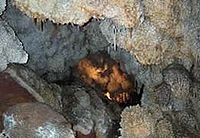 Jewel
Cave Jewel
Cave
Jewel Cave is the third longest cave in the
world, with more than 195 miles (314 km) of
mapped passageways beneath the Black Hills
of South Dakota. The entrance was discovered
by miners in 1900 and was named for its
calcite crystals. |
|
|
Travel America |
|
|
Badlands National Park
(Beginner - Listening,
reading)
A video lesson which shows you an interesting place in America.
The English is
spoken at 75% of normal speed.
Great English listening and reading practice.
This video is all about Badlands National Park. |
|
 Travel
America Travel
America
Do you love America and American English? Learn before
you travel. Facts and other cool stuff about your
favorite U.S. state. Visit the Fun Easy English Travel
America pages. Read about the beautiful National
Forests, Parks, and Monuments. Great English reading practice. |
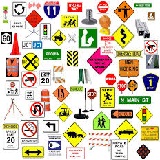 Drive America Drive America
Planning to drive in America? Learn the rules and
regulations. Great English reading practice. |
|